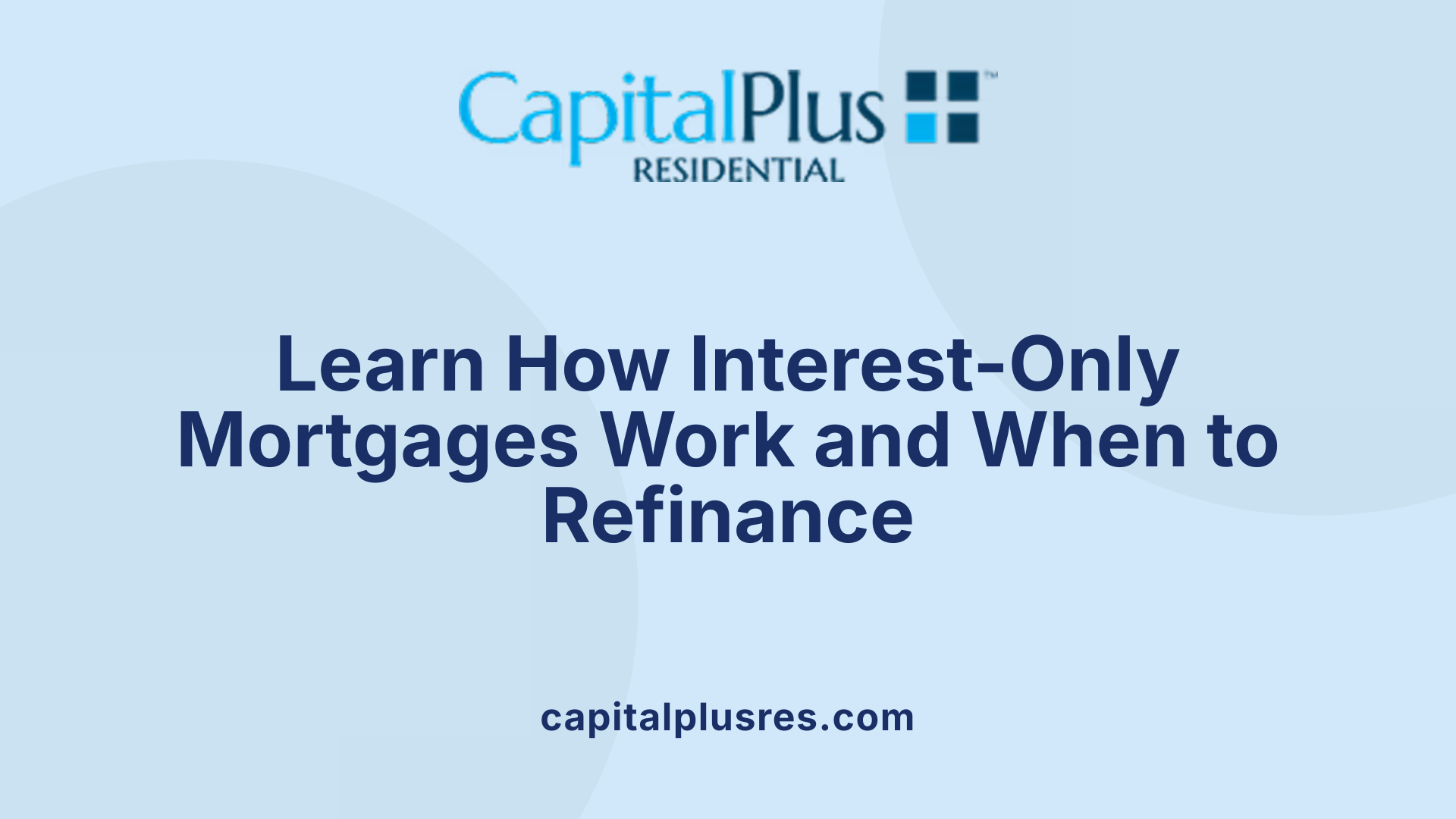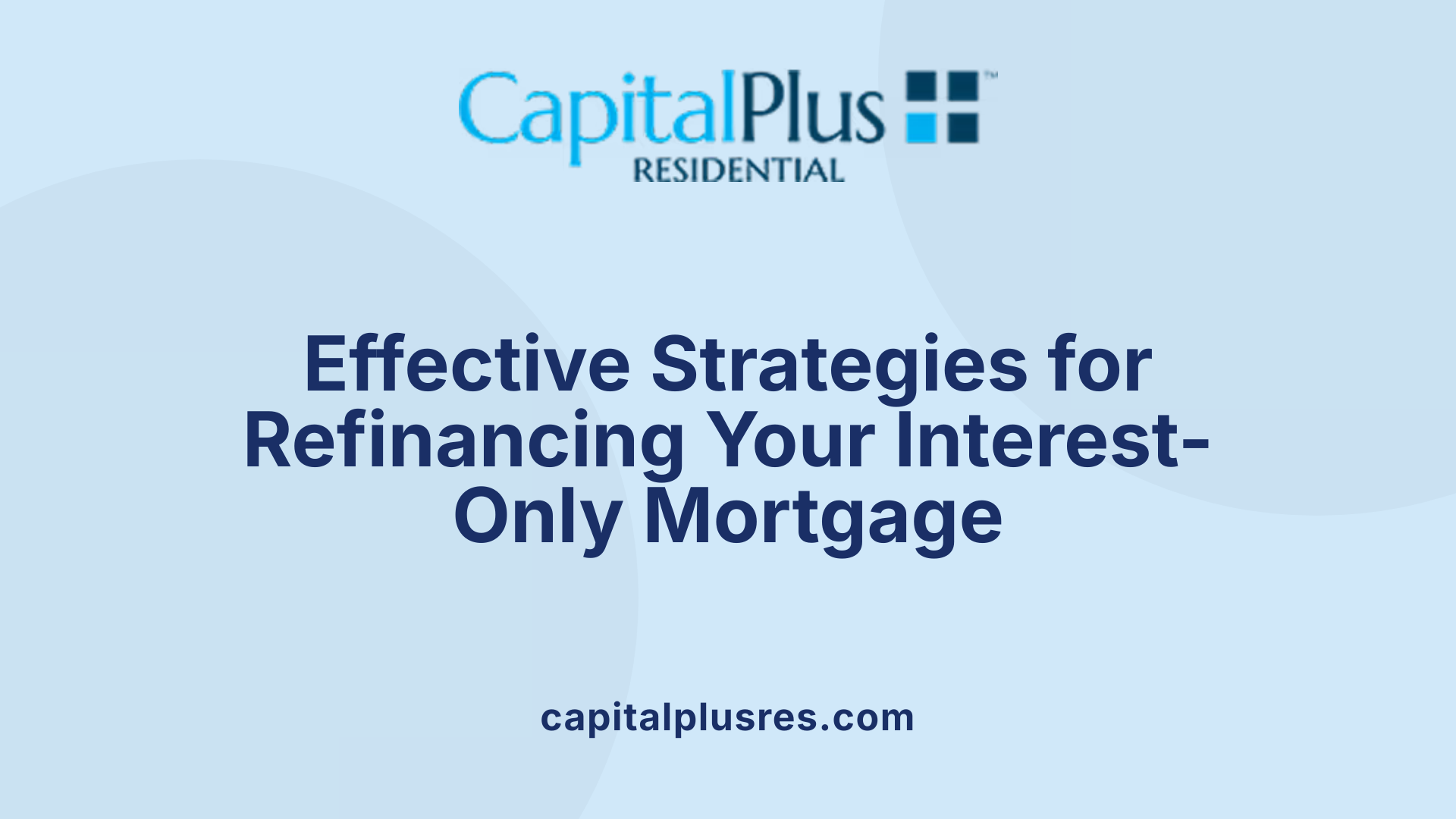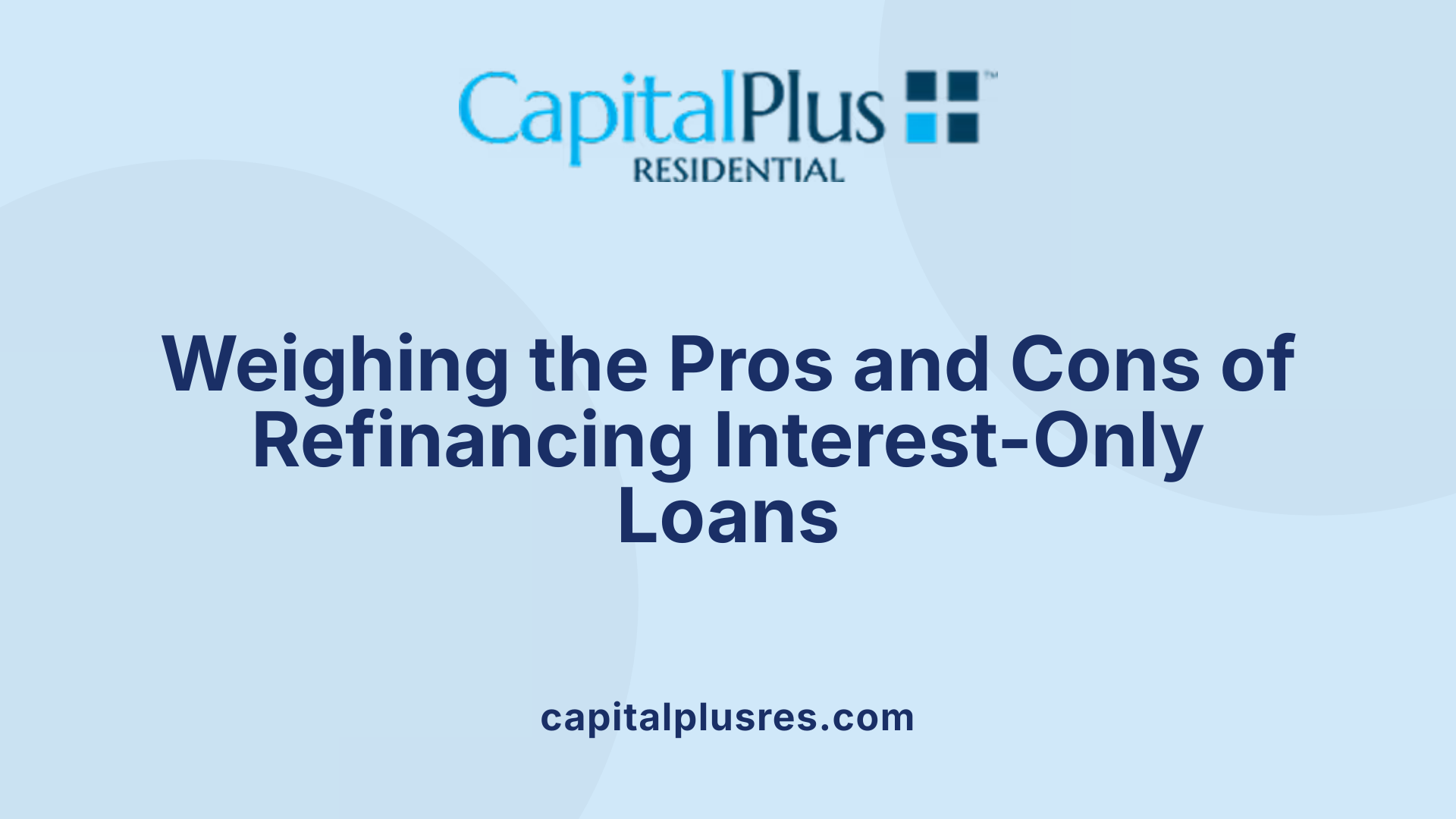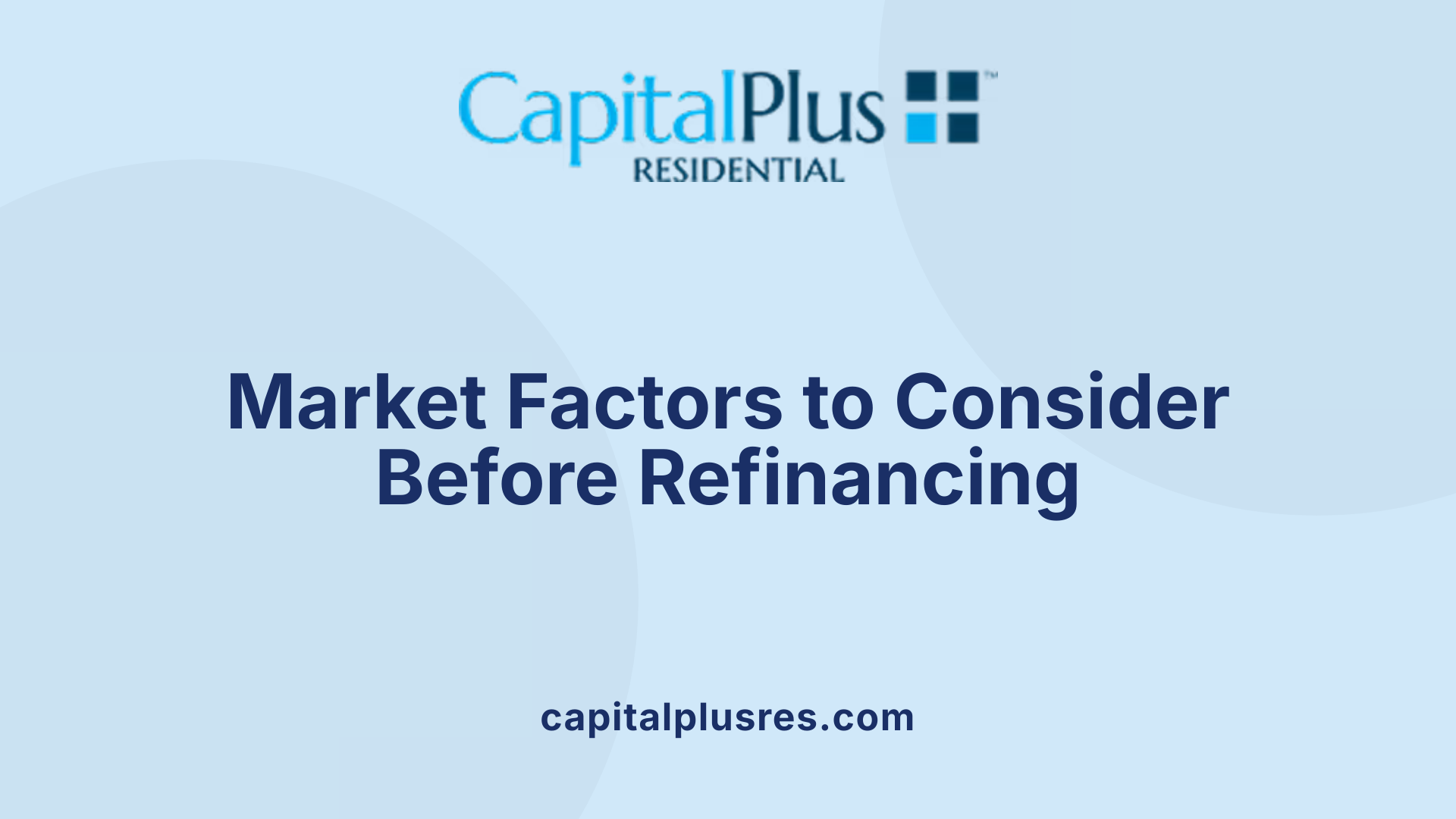Understanding Refinancing and Interest-Only Mortgages
Refinancing an interest-only mortgage is a strategic move that can help homeowners and investors optimize their financial situations. Whether aiming for lower payments, better interest rates, or more stable repayment terms, understanding the refinancing process, criteria, strategies, and risks is crucial for making informed decisions. This guide explores the comprehensive steps involved in refinancing interest-only loans and provides insights into selecting the best options tailored to your needs.
The Basics of Interest-Only Mortgages and Refinancing

What is an interest-only mortgage structure and what are its features?
Interest-only mortgages are loans where borrowers pay only the interest for a predetermined period, typically lasting 3 to 10 years. During this initial phase, monthly payments are significantly lower because they cover just the interest charges. This structure is especially appealing to those seeking to manage cash flow effectively, such as investors or individuals expecting future income increases.
Once the interest-only period concludes, the loan reverts to a standard amortizing format. At this point, borrowers are required to start paying both interest and principal, often resulting in substantially higher monthly payments. These rates are usually adjustable, meaning they fluctuate with market conditions after the initial fixed phase.
One key feature of interest-only loans is the flexibility to make additional principal payments during the interest-only period. This can help reduce the total interest paid and shorten the loan term if desired. However, it’s important to note that these loans do not help build equity during the interest-only phase, which can pose risks if property values decline.
Common types of interest-only loans
Most interest-only mortgages are structured as adjustable-rate mortgages (ARMs), where the fixed-interest period is followed by an adjustable phase that can lead to fluctuating payments. The interest-only period generally lasts from 5 to 10 years, but some lenders may offer shorter or longer terms.
During the initial phase, the interest rate may be slightly higher than conventional fixed-rate loans. This higher rate reflects the increased risk associated with interest-only payments and market fluctuations.
There are also variations such as interest-only home equity lines of credit (HELOCs), which allow for flexible borrowing and repayment options tied to the equity in a home.
When and why to consider refinancing your interest-only mortgage
Refinancing an interest-only mortgage can be a strategic move to improve your financial situation or adapt to changes in the market. Borrowers may consider refinancing if they want to lock in a fixed rate for payment stability, reduce their interest rate, or switch to a different loan structure better suited for their long-term goals.
Refinancing can also help manage payments after the interest-only period ends, especially if the new loan offers a lower interest rate or more favorable terms. Many opt for a rate-and-term refinance, which involves replacing the existing loan with a new one at better conditions.
Cash-out refinancing is another option, allowing homeowners to access equity for other financial needs, such as home improvements or debt consolidation. Alternatively, a cash-in refinance involves paying down the mortgage principal substantially, which can lower monthly payments or facilitate qualification for a new loan.
Streamline refinancing programs, especially for government-backed loans like FHA or VA, provide simplified processes with fewer requirements.
How to refinance an interest-only mortgage?
Refinancing an interest-only mortgage involves several steps:
- Assess your current financial situation and identify your goals.
- Shop around with various lenders to compare offers.
- Complete the application process, submitting necessary documents such as income verification, assets, and debt details.
- Undergo underwriting, which may include a property appraisal and credit check.
- Review and lock in your interest rate.
- Close the refinancing agreement, paying closing costs that can often be rolled into the new loan.
- Begin making payments under the new loan terms, which could include principal and interest from the start, depending on the structure.
Refinancing options also include switching from principal-and-interest to interest-only payments or vice versa, depending on your financial needs.
Qualification criteria and requirements for refinancing interest-only loans
Successfully refinancing into an interest-only mortgage involves meeting specific eligibility criteria:
- A strong credit score generally above 700.
- A low debt-to-income ratio, typically below 36% to 43%, depending on the lender.
- Sizable home equity, often at least 15% to 20% or more.
- Steady, verifiable income with the ability to support new loan payments.
- A good credit history and documentation of assets.
Lenders also consider the borrower’s overall financial stability, including employment status and future income prospects. Higher interest rates are common, reflecting the increased risk.
Risks and benefits of refinancing interest-only loans
Refinancing into an interest-only loan can offer benefits such as improved cash flow, lower initial payments, and flexibility for property investors or those expecting increased earnings.
However, it also comes with notable risks:
- Payments increase significantly once the interest-only period ends.
- Little to no equity is built during the interest-only phase.
- The possibility of owing more than the property’s value if market conditions decline.
- Stricter qualification criteria and higher interest rates than traditional mortgages.
Considering these factors, it’s crucial for borrowers to evaluate whether they can handle potentially higher payments in the future and whether the strategic benefits outweigh the risks.
Summary Table of Interest-Only Mortgages and Refinancing
| Aspect | Details | Additional Info |
|---|---|---|
| Typical interest-only term | 3-10 years | Commonly 5-7 years |
| Post-interest-only phase | Payments include principal & interest | Payments increase significantly |
| Qualification criteria | Credit score >700, equity >15%, DTI <36% | Stricter than traditional loans |
| Benefits | Lower initial payments, flexibility | Suitable for investors and expecting income growth |
| Risks | No equity buildup, higher payments later | Market decline may lead to negative equity |
| Refinancing options | Rate-and-term, cash-out, fixed-rate | Depends on market & individual goals |
Understanding the structure, benefits, and risks helps borrowers make more informed decisions about interest-only mortgages and refinancing strategies to best fit their financial plans.
Strategies for Refinancing Interest-Only Loans

What strategies can be employed when refinancing an interest-only mortgage?
Refinancing an interest-only mortgage offers several options to better align your financial goals and adapt to market conditions. One common approach is to switch to a traditional amortizing loan, where both principal and interest are paid from the start, helping to build equity faster. This can provide more long-term stability and reduce the risk of owing more than the property is worth.
Another strategy is extending or shortening the loan term. Extending the term can lower monthly payments, making them more manageable if your cash flow is limited or if you expect income increases in the future. Conversely, shortening the term can help you pay off the loan faster and reduce total interest paid.
Borrowers may also consider utilizing cash-out options or consolidation loans. A cash-out refinance allows you to borrow against your home equity, accessing funds for investments, renovations, or debt payoff. Consolidating multiple loans into a single interest-only or amortizing mortgage can simplify payments and potentially secure better interest rates.
Market and property value considerations are critical in determining the best refinancing strategy. For example, if property values have appreciated and you have sufficient equity (typically 80% or more), you might qualify for programs that facilitate cash-out refinancing. Conversely, declining property values could limit refinancing options or increase the risk of owing more than the house is worth.
Ultimately, borrowers should evaluate their long-term financial goals, including the desire for payment stability, wealth accumulation through equity, or liquidity for investments. Consulting with a knowledgeable lender or financial advisor can help identify the optimal approach tailored to your situation.
What potential benefits do these strategies offer?
Implementing thoughtful refinancing strategies can significantly improve your financial outlook. Switching from interest-only to an amortizing or fixed-rate loan can provide predictable payments, reducing uncertainty once the interest-only period ends.
Building equity sooner through amortizing payments ensures a rising stake in your property and can lower the risk of negative equity, especially if property values stagnate or decline.
Extending the loan term generally results in lower initial payments, easing monthly cash flow, which is advantageous for borrowers anticipating future income growth or managing variable income streams.
Utilizing cash-out refinancing unlocks access to your home’s equity, which can be reinvested in other assets, used for home improvements, or consolidated to reduce higher-interest debts. These options add financial flexibility and opportunities to leverage your property investment.
For property owners with multiple rental units or investment properties, selecting specialized loans such as portfolio or DSCR loans allows financing solutions tailored to the income streams generated by these assets. This enables more strategic long-term planning.
Nevertheless, these benefits come with caveats. Extended loan terms or cash-out options may lead to higher overall interest payments. Increased payments after the interest-only period can strain finances if not carefully planned. Also, declining property values may limit refinancing capabilities or increase loan-to-value ratios beyond acceptable limits.
In conclusion, exploring these refinancing strategies offers opportunities to enhance financial stability, optimize cash flow, and position property investments for future growth. Careful planning and expert guidance are recommended to maximize benefits while minimizing risks.
Benefits and Risks of Refinancing Interest-Only Mortgages

What are the benefits and potential risks of refinancing interest-only loans?
Refinancing interest-only loans can bring several advantages for homeowners and investors. One significant benefit is the opportunity to secure lower interest rates and better loan terms, which can reduce monthly payments and overall borrowing costs. Additionally, refinancing allows borrowers to transition from interest-only payments to a traditional principal-and-interest structure. This shift can help build equity in the property over time, ultimately aiding in long-term wealth accumulation.
Another advantage is the chance to convert an interest-only loan into a more stable payment plan, reducing financial uncertainty. For investors, refinancing might facilitate accessing better financing conditions suited for ongoing property management or investment strategies.
However, this process isn’t without risks. After the interest-only period ends, monthly payments increase significantly as both principal and interest are due, which can strain budgets if not anticipated. Closing costs, including origination, appraisal, and legal fees, can also add up, sometimes making refinancing less financially attractive.
If property values decline, refinancing options could become limited or more expensive because lenders require sufficient equity backing the loan. Borrowers should thoroughly evaluate their future financial situation, market trends, and their long-term goals before refinancing an interest-only mortgage.
How can refinancing influence your long-term financial health?
Refinancing has the potential to positively impact your fiscal outlook. For example, switching to a fixed-rate mortgage can eliminate payment unpredictability, allowing for better budgeting and long-term planning.
Reducing the interest rate through refinancing can lower the total amount paid over the life of the loan, decreasing overall debt. Moreover, consolidating higher-interest debt or opting for a cash-out refinance can provide immediate capital for investments, home improvements, or debt repayment.
On the downside, poorly managed refinancing might lead to higher total interest costs if longer loan terms are chosen or if market interest rates rise after an initial fixed period. Additionally, if the home’s value decreases, the ability to refinance on favorable terms can diminish, potentially delaying or eliminating beneficial refinancing options.
Careful assessment of market conditions, personal financial stability, and long-term goals is essential. Consulting with experienced loan officers can help tailor refinancing strategies that support sustainable financial health.
Additional Details on Refinancing Options for Interest-Only Mortgages
| Refinance Type | Description | Suitable For | Common Features |
|---|---|---|---|
| Rate-and-term refinance | Replacing existing mortgage with one that has a different rate or term | Those seeking better rates/terms | May involve closing costs, can help lower monthly payments |
| Cash-out refinance | Borrow more than owed and take the difference in cash | Home improvements, debt repayment | Increases loan amount, higher interest rates, potential tax benefits |
| Cash-in refinance | Pay lump sum to reduce principal | Looking to lower payments or qualify for better rates | Lower mortgage balance, reduces interest over time |
| Adjustable-rate mortgage (ARM) | Convert fixed-rate to an ARM or vice versa | Borrowers wanting payment flexibility | Adjusts rate periodically, opportunities to pay less or lock-in rates |
| Refinancing with HELOC or home equity loan | Convert or consolidate debt into another loan type | Those with sufficient home equity | Can offer flexible repayment terms, lower interest rates |
Considerations for Homeowners and Investors
Interest-only refinancing can be advantageous for certain financial situations, especially if the borrower plans to sell or refinance before the interest-only period ends. Investors often use these loans to maximize tax deductions, as interest payments may be deductible.
Owner-occupiers who meet specific criteria—such as an 80% to 90% loan-to-value ratio, strong financial position, and good credit—may qualify for refinancing options. Nonetheless, borrowing costs tend to be higher with interest-only loans due to elevated interest rates.
Post the interest-only phase, payments can increase sharply, necessitating strategic planning. Borrowers should weigh the risk of owing more than the property's value if market prices fall, which can lead to refinancing challenges.
Final Considerations
Refinancing can be a useful tool to improve your fiscal position if approached wisely. Lower interest rates, better loan conditions, and alignment with financial goals are achievable benefits.
Conversely, the risks include increased payments after the interest-only term, higher total interest, and potential financial exposure during market downturns.
Before proceeding, evaluate your ability to handle higher future payments, estimate closing costs, and consider your long-term plans. Working with qualified professionals can assist in crafting a refinancing strategy that supports sustainable financial growth.
Implications and Considerations in Refinancing

What are the implications and considerations involved in refinancing interest-only mortgages?
Refinancing interest-only mortgages requires thorough planning and understanding of the potential impacts on your finances. These loans often feature a period where payments only cover interest, meaning no equity is built during this time. When considering refinancing, it’s essential to anticipate the increase in monthly payments once the interest-only period concludes, as both principal and interest will need to be paid. This transition can significantly alter your budget.
Economic conditions and interest rate trends are vital factors. If your loan is adjustable-rate, future rate hikes could lead to higher payments, increasing financial strain. Borrowers should assess their ability to handle this shift and consider whether refinancing could lock in more stable, fixed-rate options.
Long-term financial goals play a crucial role. Refinancing can help reduce costs or extend loan terms, but it also involves evaluating if the new terms will truly benefit your financial situation. For example, switching to a lower-interest fixed-rate mortgage can provide payment stability.
Additionally, the impact on home equity must be considered. Since interest-only loans do not contribute to equity accumulation during the interest-only period, refinancing strategies should include plans for building equity or leveraging future property appreciation.
The overall decision hinges on your exit strategy—whether you aim to sell, refinance further, or pay off the loan. Ensuring a clear plan helps avoid potential pitfalls, such as owing more than the property’s value if market conditions decline.
What market factors influence refinancing options, including interest rate movements and property values?
Market conditions have a profound effect on refinancing prospects. Fluctuations in interest rates are among the most significant influences. When rates fall, refinancing becomes more attractive because borrowers can secure lower payments or better loan terms. Conversely, rising rates may discourage refinancing, especially if the new rate exceeds the existing one.
Property values are equally important. When home prices decline, borrowers might face restrictions on refinancing due to loan-to-value (LTV) limits, reducing eligibility for favorable terms or cash-out options. Conversely, rising property values can increase refinancing opportunities and the amount of equity available.
Economic health, housing market trends, and regulatory environment also shape refinancing strategies. For instance, a booming housing market with rising prices can facilitate cash-out refinances, enabling borrowers to access additional funds.
Staying informed about these market dynamics assists borrowers in timing their refinancing to maximize benefits while minimizing risks. Consulting with lenders and financial advisors can provide insights into current conditions, helping borrowers make well-informed decisions.
Table Summarizing Key Factors in Refinancing Decisions
| Factor | Impact | Recommendations |
|---|---|---|
| Interest Rate Trends | Lower rates favor refinancing; higher rates deter | Monitor market; consider locking rates if favorable |
| Property Values | Rising values increase eligibility; falling values can restrict access | Assess home appraisals; plan accordingly |
| Loan Type and Structure | Fixed-rate offers stability; ARMs may adjust | Evaluate risk tolerance; compare options |
| Borrower’s Financial Profile | Income stability, credit score, debt ratio affect approval | Maintain good credit; improve financial standing |
| Market Conditions | Economic stability influences loan terms and availability | Stay updated on housing and economic trends |
Understanding these considerations ensures that borrowers approach refinancing with a comprehensive view, aligning their choices with their broader financial strategies.
Comparing Different Refinancing Solutions
How do different refinancing options compare for interest-only mortgages?
Refinancing interest-only mortgages involves evaluating various strategies based on goals such as payment stability, cost savings, or accessing home equity. Rate-and-term refinancing adjusts the interest rate or the length of the loan, which can reduce monthly payments or shorten the duration. It is suitable for borrowers seeking lower interest costs or more manageable payments.
Cash-out refinancing allows homeowners to borrow more than they owe, converting home equity into cash for purposes like home improvements or debt repayment. Conversely, a cash-in refinance involves paying down the principal to lower monthly payments or qualify for better terms. Both choices impact the mortgage balance and future payment structure.
The typical refinancing options include converting to a fixed-rate loan for stability or switching to a variable-rate for potentially lower initial payments. Refinancing can also involve moving from an interest-only structure to a traditional amortizing loan, where the principal is paid down over time.
To compare these options effectively, homeowners should consider interest rates, closing costs, and the length of time they plan to stay in the home. Loan calculators and detailed estimates from lenders can help weigh the overall savings and costs of each approach.
What operational features should borrowers understand about refinancing interest-only loans?
Interest-only mortgages offer initial low payments because borrowers pay only interest for a specific period, typically 5 to 10 years. During this interest-only phase, no equity is accumulated since no principal payments are made.
Most interest-only loans are adjustable-rate mortgages (ARMs), meaning that after the initial interest-only period, the rate adjusts periodically with the market, often leading to increased payments.
Qualification for these loans requires strict criteria: high credit scores (often above 700), higher down payments (around 15%), and low debt-to-income ratios. These stringent requirements compensate for the higher risk that lenders take due to the loan structure.
Once the interest-only period concludes, monthly payments increase considerably because they now include both principal and interest. Borrowers can face challenges refinancing at favorable terms or selling the property if property values decline.
Refinancing interest-only loans offers options to switch to fixed-rate mortgages, extend or shorten the loan term, or convert back to principal and interest payments. However, these refinances often involve closing costs and require thorough financial review.
Potential risks include the increased future payments, the absence of equity growth during the interest-only period, and the possibility of owing more on the home than it is worth if market values drop.
Overall, understanding these operational features and planning ahead can help borrowers mitigate risks and align their refinancing choices with their financial strategies.
Comparing different refinancing strategies for interest-only mortgages
| Refinancing Type | Description | Benefits | Drawbacks | Suitability |
|---|---|---|---|---|
| Rate-and-term | Change interest rate or duration | Lower payments; shorter loans | May involve costs; not for equity growth | Long-term homeowners |
| Cash-out | Borrow more against home equity | Access to cash for needs | Increases loan balance; higher risk | Borrowers needing liquidity |
| Fixed-rate | Convert to fixed interest rate | Payment stability; predictability | Usually higher initial rate | Risk-averse homeowners |
| Adjustable-rate | Keep or convert to ARM | Lower initial payments | Payments can fluctuate over time | Expecting income growth or short-term stay |
| Principal pay-down | Make extra payments to reduce principal | Build equity; lower future interest | Increased payments during payoff phase | Those planning to stay long-term |
Final thoughts
Choosing the right refinancing approach depends heavily on individual financial situations, market conditions, and long-term plans. Homeowners should consider their ability to handle higher future payments, their plans for the property, and whether they seek short-term flexibility or long-term stability.
Consulting with knowledgeable loan officers and using financial tools can aid in making informed decisions. Understanding the operational nuances of interest-only and other refinancing options helps homeowners navigate their choices more confidently, ensuring their mortgage aligns with their financial goals.
Smart Strategies for a Secure Financial Future
Refinancing an interest-only mortgage can be a powerful tool for improving your financial stability and achieving your long-term goals. By understanding the process, qualification requirements, various strategies, and potential risks, borrowers can make well-informed decisions. Consulting with experienced lenders and financial advisors ensures that refinances are aligned with current market conditions and personal circumstances. Whether aiming to lower payments, lock in fixed rates, or access home equity, a thoughtful approach to refinancing can enhance your financial health and provide peace of mind for the years ahead.
References
- Interest Only Refinance
- Interest-Only Loan
- How Does an Interest-Only Mortgage Work?
- Top 6 options for mortgage refinance
- Refinance A HELOC: How To Restructure A Home Equity ...
- Can You Refinance An Interest Only Loan?
- From home loans to refinancing, we've got you covered.
- Understanding Interest-Only Mortgages: How They Work, ...
- Mortgage Refinance and Home Refinancing from ...
Latest Blog


Get Pre-Approved Today
Start your secure online application now so you can get pre-approved for a mortgage (and close on your dream home) quickly within 5 minutes.









